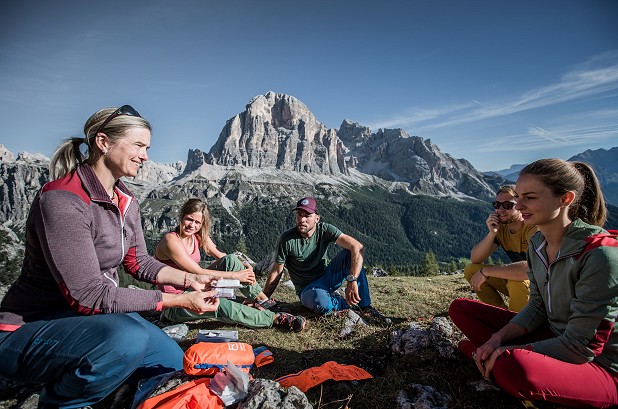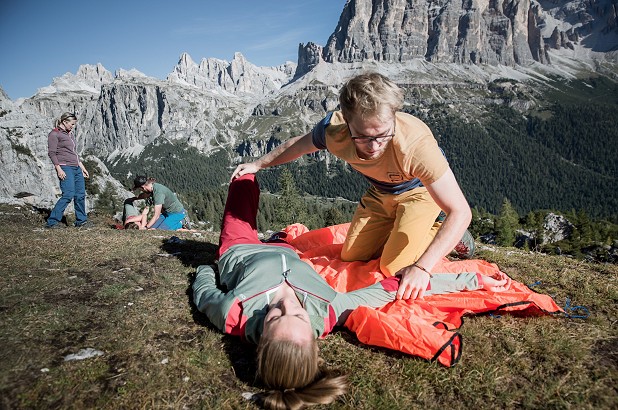
1. What to do in an emergency situation
Mountains mean freedom. But the wildness of nature also holds dangers for humans. A short moment of carelessness, a wrong step or an fortunate incident can lead to a serious accident for the rope team. Particularly in remote areas, one should always be able to guarantee adequate first aid.
In contrast to areas with well-developed infrastructures, site-specific factors make it difficult to rescue people in alpine terrain. Inaccessibility of the scene of the accident, long access to the rescue services, no reception or weather-specific factors can delay a rapid rescue. That's why first aid should be part of the basic knowledge of every mountaineer.
Hence one of Ortovox's most important offers is the SAFETY ACADEMY LAB ROCK, a digital learning platform for alpine climbing and alpine first aid comprising more than 40 video-tutorials, interactive quizzes and expert know-how.
Chapter four – first aid – is the latest SAFETY ACADEMY release. It contains in-depth information on first aid in the mountains and prepares mountaineers for emergencies in the outdoors. The chapter starts with the introduction of the so called first aid algorithm. It clarifies the most important steps to be taken in an emergency every first responder should know by heart.
- Safety: After the accident has occured the first responder should take a step back to look at the situation from a distance. A calm mental state is now crucial. Furthermore, self-protection and protection of the group must be taken into account. Is the accident site at risk of rockfall or falling? If safety is ensured, it should be checked whether the victim has a badly bleeding wound. If so, it should be provided with a pressure bandage.
- Consciousness: Next, you should check to see if the accident victim is conscious. If so, first aid can be provided and an emergency call be made. If not, you should check in a further step whether the person is still breathing. If the person has stopped breathing, the resuscitation is started immediately. Otherwise, you put the person in a stable recovery position.
- Wait: Wait for the mountain rescue service and provide psychological support to the victim.
Checking vital functions using the ABC techniques
The ABC is a model that can be used to quickly treat heart and circulatory issues.
A)AIRWAY
Turn the person on their back
An intensive mouth check is no longer included as part of first aid. However: If it is apparent that the airways are blocked by foreign bodies, these should be removed.
B) BREATHING
You should regularly check the person is breathing.
See: Is the ribcage moving?
Hear: Can the first responder hear the person breathing?
Feel: Can the first responder feel a warm airflow coming from the accident victim's mouth or nose?
If they are not breathing, are breathing infrequently or are gasping for air, you must begin resuscitating.
C) CIRCULATION
If the accident victim is breathing normally, there is proper circulation. If they are not breathing normally, there is no circulation.
2. First Aid
The SAFETY ACADEMY LAB ROCK covers more than 27 alpine emergency situations: From physical injuries like breaks and cuts to the symptoms of various ailments such as anaphylactic shock, heart attacks and snakebites. Rescue methods for unresponsive (unconscious) persons, in which the first responder plays a crucial life-saving role, are dealt with in the SAFETY ACADEMY chapter particularly intensively.
Sprains, ligament and joint injuries caused by twisting, stumbling or tripping are among the most common injuries when mountaineering, or during approach and descent on a climbing tour.
Most frequently affected are the knee or ankle, where either the joint capsules or ligaments get overstretched or torn.
What to do?
- RECOGNIZE SYMPTOMS
- CONSTRUCT A COLD PACK
You can cool the area by making a cold pack out of a disposable glove filled with moist soil or water. - APPLY 'RICE' BANDAGE
The injured person can place the improvised cold pack on the most painful area without removing any clothing. The first responder can now fix the cold pack with an elastic bandage.
Warning: do not remove the climbing boot under ANY circumstances. An exception are climbing shoes. - STEP 4: EMERGENCY CALL YES OR NO?
Compression helps prevent further swelling and the cold pack helps to reduce the pain. Now make a joint decision as to whether descending or rappelling is possible or whether an organized rescue is required. If you have to wait, the patient should be kept warm and be well taken care of.
A tumble from a great height or a fall on to a root or trekking pole lead to significant injuries and internal bleeding in the abdominal area. This clinical picture is called a blunt abdominal trauma. First aid can save lives here.
What to do?
- RECOGNIZE SYMPTOMS
The circumstances of the accident can give a clue as to whether the stomach has been injured. Bruising and blue flecks are also indicators of a blunt stomach injury.
Pain in the stomach and a rigid abdominal wall often only set in later. A significant loss of blood in the abdomen can lead to typical shock symptoms such as cold sweat and paleness, right up to loss of consciousness. A life-threatening situation can ensue if a professional rescue team is not promptly alerted. - MAKE AN EMERGENCY CALL IMMEDIATELY
Every minute counts! - KEEP THE PATIENT WARM AND TAKE GOOD PSYCHOLOGICAL CARE OF THEM
The injured person should be cushioned, kept warm and supported in a relieving posture (usually in the fetal position or on their back with raised knees). - STABLE RECOVERY POSITION AND/OR RESUSCITATION
If the injured person loses consciousness, check their breathing. If they are breathing regularly, put them in the stable recovery position. If the injured person is not breathing regularly, resuscitate until the rescue team arrive or until the first responder is exhausted.
3. Rescue Techniques
One should be able to avoid accidents in alpine terrain by preparing well and judging one's own ability realistically. Exposure, large gaps between pitons or difficult rescue conditions can quickly lead to life-threatening situations.
An express pulley or the prusik technique are rescue methods that can aid the follower in ascending the rope.
But knowing how to bivouac in the mountains can also be important in an emergency.
You can find all the Ortovox video-tutorials here.
Cut, broken arm, spinal injury ... How to act correctly? In emergency situations you must act quickly, effectively and correctly. That's why in-depth first aid knowledge is of paramount importance for every mountaineer – and can save lives in an emergency. Test your knowledge of four ailments using the interactive first aid quiz and discover essential information about key life-saving emergency measures in alpine surroundings.
Since 1988, mountain sports apparel made with wool has enhanced the ORTOVOX product range. As wool experts, ORTOVOX has developed a wear comfort system from the first to the third layer.






Comments